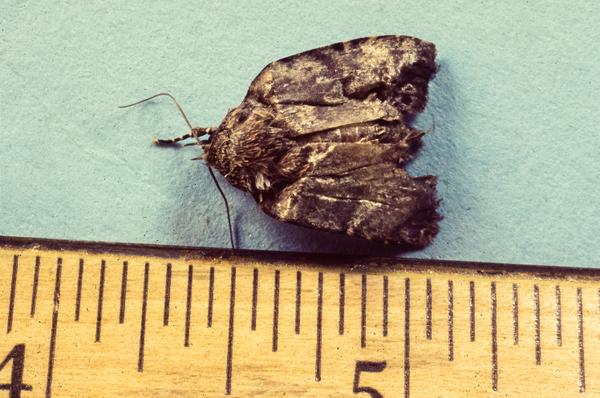Background and Description
In North Carolina there are at least three species of noctuid moths that are commonly referred to as green fruitworm (GFW) on apple, with the speckled green fruitworm (Orthosia hibisci), the widestriped green fruitworm (Lithophane antennata), and the humped green fruitworm (Amphipyra pyramidoides) being the most commonly encountered. While these three species are the usual cause of damage, there are additional species that are sometimes referred to as green fruitworm.
GFW are generally considered sporadic pests that do not occur every year. The last time GFW damage was a significant issue for commercial growers in NC was the period from 2010 to 2012. At that time, GFW had not been a significant pest for 25 years, and very little GFW damage has been observed since.
Regardless of species, GFW adults are brown or gray moths with 11/2 to 13/4-inch (38 to 45mm) wingspans. Larvae are about 11/2 inches (38mm) long when fully grown. They are green during all instars and typically have white or yellow bands on the backs and sides of their bodies.
Life history
These insects generally have a wide host range that includes deciduous shade, forest and fruit trees and shrubs. Some species, such as the humped green fruitworm, lay eggs in the late fall and larvae hatch near bloom. Other species emerge as adults in the early spring near green tip and lay eggs on twigs and leaves up to early bloom. Larvae feed on both foliage and fruit, with the damage to fruit occurring any time between early fruit set to first cover.
Damage
Many, but not all apples damaged by green fruitworms abort. Some will remain through harvest and exhibit deep corky scars and indentations. Shown below is some fresh feeding on apple, some older scars on small fruit, and a file photo of damaged fruit at harvest.
The extent of damage can vary depending on the intensity of infestation and insecticides used before bloom. A survey of orchards in Henderson County in 2012, the last year we observed significant levels of damage in NC, found that on average about 2.8% of fruit were damaged. Among those damaged fruit, about half (i.e., 1.5% of total fruit) remained on the tree through harvest. Survey results in June of 2012 also revealed the following relationship between the level of damage and insecticide use.
● The highest damage (5.8%) occurred in orchards that sprayed only Lorsban at green tip, no other insecticide before bloom.
● Lower levels of damage (2.4%) occurred in orchards that sprayed a neonicotinoid (Assail or Actara) between tight cluster and pink.
● The lowest level of damage (0.6%) occurred in orchards that sprayed Intrepid at early petal fall, in addition to a neonicotinoid at tight cluster to pink.
Several other species of insects also cause early season damage similar to that of green fruitworms, most notably the obliquebanded leafroller (OBLR). The OBLR is a key pest of apples in northern production regions (NY, MI, and WA), but it is rarely encountered in NC. We routinely monitor for OBLR with pheromone traps in several commercial orchards, but captures in Henderson County rarely exceed 2 or 3 moths. Higher numbers do occur in Polk and Cleveland Counties, where peak weekly captures of 25 to 30 moths/trap are common, but these levels are still considered low.
Monitoring and Control
Damage to fruit can occur shortly after new fruit are formed, and before all petals have fallen off of a tree. Hence, the need to protect bees and delay petal fall sprays until late-maturing varieties have reached the true petal-fall stage in orchards with multiple varieties can lead to increased levels of damage on earlier blooming varieties. Hence, the most effective approach to control green fruitworms is to apply an insecticide that is non-toxic to bees at early petal fall. The only two insecticides that meet the criteria of being registered on apples, non-toxic to bees, and effective against fruitworms are Intrepid and Bacillus thuringiensis products such as Dipel, Xentari or Agree. These products are non-toxic to bees, with Intrepid effective at 6 oz/acre and the Bt’s at 1 lb/acre.
Because green fruitworms are considered sporadic pests, it is advisable to monitor for their presence before making the decision to apply an insecticide specifically targeting them. Fruitworm actually feed more on foliage than fruit, and feeding damage to foliage precedes feeding on fruit. Hence, the presence of feeding damage on new shoot growth at petal fall on early-maturing varieties can used as a guide to the presence or absence of larvae in an orchard.
See the "Pest and Orchard Management Program" section of the Integrated Orchard Management Guide for Commercial Apples in the Southeast for the most current control guidelines.
Publication date: April 13, 2016
Reviewed/Revised: Nov. 11, 2025
N.C. Cooperative Extension prohibits discrimination and harassment regardless of age, color, disability, family and marital status, gender identity, national origin, political beliefs, race, religion, sex (including pregnancy), sexual orientation and veteran status.










